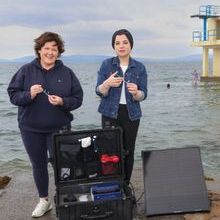Researchers create new device for on-the-spot water testing
07 August 2024

Researchers at University of Galway have developed a new, portable technology for on-the-spot testing of water quality to detect one of the most dangerous types of bacteria.
Ireland regularly reports the highest crude incidence rates of the pathogen Shiga toxigenic Escherichia coli - STEC for short - in Europe over the recent years.
The bacteria produces the harmful Shiga toxin, which, if ingested by humans, can cause severe stomach illnesses and, in some cases, life-threatening complications especially in children under 5 years, older people and immunocompromised individuals.
A work led by Dr Zina Alfahl, lecturer in bacteriology in the University’s College of Medicine, Nursing and Health Sciences, and Dr Louise O’Connor, senior research fellow with the University’s College of Science and Engineering, developed a technology for rapid, sensitive and accurate testing of STEC in water sources, including rivers, lakes and wells.
The results have been published in the journal, Microbiology.
Dr Alfahl said: “Our technology is a significant advancement in on-site water testing. It is portable, straightforward and safe to use. It is accurate, highly sensitive and the results are delivered quickly, on-site.
“We are hoping that Environmental Health Officers and groundwater schemes in Ireland could use the technology on-site allowing for more frequent testing especially in or after extreme weather, periods of intense rainfall, because it is those conditions which lead to water supplies being contaminated.”
Dr O’Connor said: “This technology could be a crucial intervention in helping to prevent outbreaks of infection in families and communities using wells, private water supplies and groundwater schemes."
"Immediate results can help public health officers and water management authorities make informed decisions to protect public health. This rapid response capability is crucial for preventing the spread of waterborne diseases and ensuring the safety of drinking water."
STEC is normally found in the intestines of healthy animals like cows and sheep, which carry it without getting sick. The bacteria spreads to people through contact with animal waste, or by eating or drinking contaminated food or water.
A small sample of water can be tested on-site using isothermal amplification technology which can identify the genetic markers of STEC bacteria, and related E. coli. The results are delivered in about 40 minutes through a reading on screen. Traditional lab testing of samples can take days for results to be returned.
The research, funded by Environment Protection Agency through the DERIVE project, tested samples from various water sources, including groundwater wells, rivers, a turlough and a farm drain on the Corrib catchment in Galway. Of the samples tested 61% were positive for the presence of this dangerous pathogen.
Dr Alfahl said: “Our testing is sensitive enough to identify as low as two cells of the STEC bacteria. The gold standard for testing is culture in a lab, but this can take days and often weeks, and on occasion can return a false negative result – just because the culture does not grow in the lab does not always mean the bacteria has not been present in the water. Our test removes the necessity for samples to go to a lab. It offers on-the-spot results and is of huge benefit to the people using the water as a first-step in identifying a contamination and a potential health risk.”
Dr O’Connor said: “This new testing method is particularly important for areas that rely on private groundwater wells, which can be more prone to contamination. In Ireland, a significant portion of the population depends on these for their drinking water - about 720,000 people, or one in every 5 households, but quality has been an issue as regulation is less stringent on these sources and testing is less frequent.”
NOTES FOR EDITORS
Media queries to [email protected]
Photo – Dr Louise O’Connor and Dr Zina Alfahl, University of Galway. Credit Martina Regan.
The paper 'A rapid on-site loop-mediated isothermal amplification technology as an early warning system for the detection of Shiga toxin-producing Escherichia coli in water' by Zina Alfahl, Sean Biggins, Owen Higgins, Alexandra Chueiri, Terry J.Smith. Dearbháile Morris, Jean O'Dwyer, Paul D.Hynds, Liam P.Burke, and LouiseO’Connor is published in Microbiology under the following:
URL: https://www.microbiologyresearch.org/content/journal/micro/10.1099/mic.0.001485
DOI: 10.1099/mic.0.001485
About the Microbiology Society
The Microbiology Society is a membership charity for scientists interested in microbes, their effects and their practical uses. It has a worldwide membership based in universities, industry, hospitals, research institutes, schools, and other organisations. Find out more at microbiologysociety.org.
For further information please contact [email protected]
About University of Galway
Established in 1845, University of Galway is one of the top 2% of universities in the world. We are a bilingual university, comprised of four colleges, 18 schools and five research institutes, with more than 19,000 students, including around 3,000 international students. We have been accredited with an Athena SWAN Institutional Bronze Award, and 11 out of our 18 schools hold individual Athena SWAN Awards. We have more than 2,500 staff, and research collaborations with 4,675 international institutions in 137 countries. We have 133,000 alumni and 98% of graduates are in employment or further study within six months.
For more information visit https://www.universityofgalway.ie/ or view all news
Get the most from the expert commentary, views and stories from University of Galway on our Cois Coiribe platform https://impact.universityofgalway.ie/
Image: Martina Regan.
